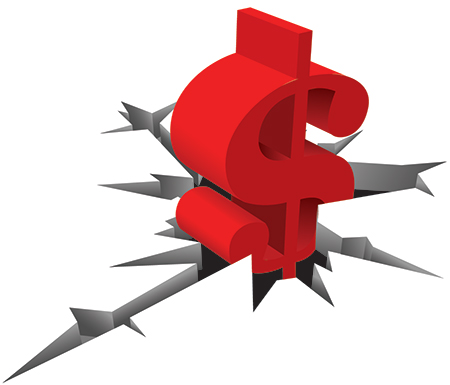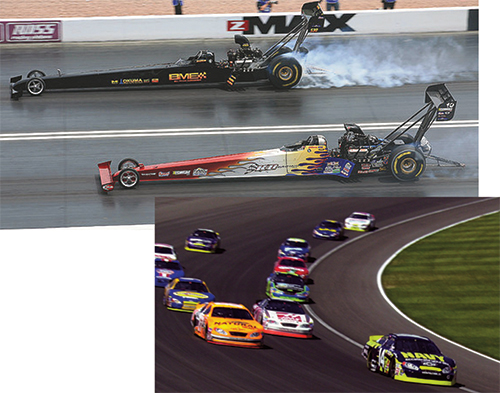Slow Down to Run Faster
It seems illogical that the new capabilities provided by servo presses revolve around the ability to slow down during the stroke, yet increase overall stroke rate.
Press technology—conventional mechanical presses and servo presses—is analogous to dragster and stock-car racing. While the dragster driver accelerates in a straight line as quickly as possible, a stock-car driver negotiates a set of curves in the track—he must slow down and accelerate rapidly and repeatedly. Conventional mechanical presses operate similarly to the dragster—they run great full out with no corners (or complex tooling operations) in sight. But, they lack an ability to accelerate or decelerate once in motion. Maximum press speed is dictated by the most challenging die operation.
Yet, most stamping jobs are loaded with curves. A series of operations (or curves) must occur during each press stroke. Among these curves (die operations):
1) Eject the part(s) completed in the last stroke.
2) Feed the material into the next tool or station.
3) Close the tool to bring it into contact with the part.
4) Form the part by continuing to close the tool toward the bottom of the stroke. During this travel, the part may be pierced, cut, bent, coined or drawn. Often, several of these operations occur at various die stations and at different points in the stroke.
5) Close fully to 180 deg. of stroke, setting forms and finishing coining operations.
6) Shed scrap from cutting or piercing operations.
Each of these operations can become a bottleneck,
More on Servo-Press Applications MetalForming has presented several case studies on how metal stampers are leveraging servo-press technology, including one in this issue on Milwaukee’s Acro Metal Stamping (pp. 32-33). Here’s one more, worthy of a trip down memory lane, from our September 2012 issue. Taking on very complex and increasingly large, high-tonnage automotive stamping jobs—that’s how Batesville Tool & Die (BTD) CEO and president Jody Fledderman characterizes his company’s focus over the last several years, as well as its approach to research and development. Describing the first production job run on its new servo-drive press, Jay Fledderman describes the productivity and quality gain realized from moving a progressive die from a conventional 1200-ton press to the servo-drive press. “The die stamps seat side brackets,” Fledderman says, “to the tune of 36,000 parts/week, about 20 percent of press capacity.” Brackets are of 0.156-in.-thick 80-KSI high-strength low-alloy steel. They’re stamped two-out from 15-in.-wide strip over 10 die stations. “We had run the job for years on one of our two 1200-ton presses,” Fledderman continues, “learning to live with and compensate for as much as 145 tons of reverse tonnage. While the addition of hydraulic dampers on the press brought snapthrough force down to 115 tons, our press operators and diesetters found the dampers burdensome and cumbersome.” and the ability of the servo press to slow down and navigate those curves, and then accelerate to a higher average speed in the straightas ultimately results in an overall increase in stroke rate. Negotiating the Curves Ejecting the last parts formed—Particularly during transfer-press operations, part ejection can be impacted by press-opening speed. If the die opens too quickly, the part can jump out of the die unpredictably, driven by spring or cushion forces. This can prevent proper ejection and stop the operation. Feeding the material—There als is a maximum speed at which material can be advanced for the next press stroke. During transfer applications, rapid opening of the die can cause loss of control of the part. As the die opens, it is helpful to move rapidly to allow clearance for part movement. Then we may want to slow the process down to allow the transfer tooling to index the part. With transfer complete, we can advance quickly to the point where the die again contacts the workpiece. With progressive dies running in a servo press, this feed time also presents an opportunity to improve productivity. On very long progressions, the stamper can slow the ram somewhat during the stroke to allow time for the feed, but avoid bringing the ram to a complete stop. Conversely, on short progressions we can reverse direction without waiting for full 360-deg. rotation—pendulum mode. By shortening the distance the ram must travel between strokes, the press cycles more frequently without increasing ram speed. Closing the tool—The ability of a servo-driven press to adjust impact velocity at the instant when the tooling contacts the material can greatly improve die life, by reducing reverse load. Also, excessive impact velocity can cause spring strippers to bounce. Forming the part—Several types of forming operations have a maximum speed at which they can function while maintaining a good balance of part quality and tool life. Drawing: To avoid tearing the material during drawing, stampers use special tool coatings, lubricants and even premium-priced draw-quality steels. Servo-press technology allows a stamper to reduce slide velocity during the drawing portion of the stroke, without losing press energy and stalling the ram. This pays off in several s, including reduced lubricant consumption, and the ability to make good parts with lower-quality material and less-costly tooling, while maintaining tool life. Part quality actually can improve, since a slower draw speed minimizes heat generation to prevent distortion. Cutting/blanking/piercing: During these operations, excessive punch velocity at contact with the workpiece material can lead to significant reverse load. The ability of a servo-drive press to slow punch speed to nearly zero and yet still produce enough torque, tonnage and energy to cut can reduce reverse load by as much as 90 percent. Bending: These operations often cause springback. With some materials, stampers will program a servo press to briefly remain closed, or even restrike the part, to help set bend angles and minimize or eliminate springback. Also, bending can cause workpiece cracking—a servo press can provide extremely slow movement through the bending moment, avoiding cracking to allow room-temperature stamping of materials typically hot formed. In-die tapping: This operation’s limitation occurs during the first turns of the tap. Stampers must honor the maximum rotation speed that will yield a satisfactory tapped hole while optimizing tool life. Although the slide may only travel 0.200 in. or less to perform the restrictive portion of the tapping operation, with a conventional mechanical press the maximum tap-rotation speed—controlled by the tapping unit’s gearing and the slide speed —will dictate the press stroke rate. With a servo press, impact velocity and ram speed can be optimized over this brief travel distance to match the tapping need. Then the press can accelerate during the remainder of ram travel, greatly increasing output. Coining: When coining and performing similar operations where the material is compressed into a plastic state and flows into cavities, the operation generally benefits if the tool remains closed longer than when the job runs on a traditional crank-motion press. Slowing down when the ram is at 180 deg. will assist that material flow. Shedding scrap: To ensure that scrap sheds properly, in some cases the ram must not move too quickly when opening. A punch pulled too quickly from a die button can create a vacuum and pull a slug. And, during operations where the part web is cut, it may take some time for gravity to clear the scrap a, so it does not interfere with part ejection. With a servo press, the stamper can program the ram to slow down or dwell only for that brief portion of the stroke to allow the scrap to shed. The rest of the stroke can proceed at the optimum speed. These and other operations represent the curves in the track that would traditionally slow down the entire stroke of a conventional mechanical press. When taking on difficult-to-form materials such as stainless steels, titanium alloys and high-strength steels, the severity of the curves rises and the performance gains of a servo-drive press become even more evident. Expected Results with Servo With any given die, a stamper will experience some combination of the operations described above. Each operation has an optimum slide velocity that balances output (strokes/min.), tool life and part quality. In a standard press, the operation that requires the slowest slide velocity becomes the bottleneck, and forces the entire stroke to run at that speed. With a servo press, we can vary the slide speed during the stroke so that each operation runs at its optimum velocity. The result: higher throughput. Each operation affects tool life—the impact of the tool steel against the material, the heat generated during forming or drawing, the vibration caused by the reverse load created during cutting. By optimizing the speed during these operations, the stamper can increase tool life. This is especially noticeable during heavy blanking operations—here, reducing impact velocity greatly reduces reverse tonnage. Any given material will have a maximum limit on slide velocity for impact, bending, coining and drawing operations. By setting the ideal speed for each of the forming operations, but only being restricted to the that specific speed during that forming operation’s travel, we can increase formability without restraining production rate. We also can begin drawing operations higher in the stroke without tearing the material, without sacrificing output and without stalling the press due to lack of energy. We produce less heat, reducing workhardening of the part and increasing tool life. This can allow the servo press to run less-expensive materials in certain operations, reducing piece-part price. In addition to reducing workpiece-material cost, tooling cost also can be reduced thanks to use of a servo press. Improved formability allows the toolmaker to perform more forming per station. This allows stampers to reduce the number of redraws required to achieve the net shape. Restrike stations on bending operations also can be eliminated, due to the ability to stop, reverse direction and then stop-reverse again. So, we can restrike the same part two or more times all in one bending station. Also, because of the increased tool life, stampers may be able to use less expensive tool steels or coatings while maintaining an acceptable balance of speed and tool life. As noted above, by reversing the ram travel we can restrike a part in one die station. This immediate restrike does not allow the part to cool and workharden, so the restrike has greater effect than if it were done in a later die station. This ability to restrike in one station also, again, minimizes the number of required die stations. The Benefits Keep on Coming Elimination of secondary operations: Because of the ability to slow and even pause momentarily without losing energy, operations such as hardware insertion and in-die tapping and welding can be added to the automatic production cycle. This can remove the need for what were traditionally manual secondary operations, often resulting in a tremendous reduction in piece-part price. Reduced die development/debug time: Some servo presses can move in tiny increments during setup, or at least stroke at an extremely low rate. This step-feed capability reduces greatly the time required to check timing and debug new tools. As a result, lead time and associated costs from order to first production date can be minimized, especially with very complex tools. Stamping exotic difficult-to-form materials: The formability of very hard materials such as stainless and high-strength low-alloy steel is greatly increased using a servo press. These materials are very sensitive to impact velocity and forming speed, exhibit a great deal of springback, and often workharden more readily than softer materials. All of these complexities are easier to deal with in a servo press. So Who Wins the Race? The winning stamper (or race-car driver) that brakes late into the curves, accelerates early out of them, optimizes speed at every part of the race and leverages every edge allowed by the new rules will win the productivity race. No one would say the racecar drivers from the 1980s were not talented or fearless. But if they were racing with old technology and playing by old rules, they would not be very competitive today.
View Glossary of Metalforming Terms
See also: TCR-Integrated Stamping Systems
Technologies: Stamping Presses







 Conventional mechanical presses come in different configurations of drivetrains to convert rotary flywheel motion into linear slide motion. This action closes and opens dies with enough tonnage and energy to add shape to otherwise featureless sheetmetal blanks. The various drivetrain arrangements include crankshafts, eccentric shafts, knuckle mechanisms, link drives, direct drive, back-geared and double back-geared, and they all have been developed to provide tons of force; in.-tons of energy; specific slide velocities; and dwell time with the die closed.
Conventional mechanical presses come in different configurations of drivetrains to convert rotary flywheel motion into linear slide motion. This action closes and opens dies with enough tonnage and energy to add shape to otherwise featureless sheetmetal blanks. The various drivetrain arrangements include crankshafts, eccentric shafts, knuckle mechanisms, link drives, direct drive, back-geared and double back-geared, and they all have been developed to provide tons of force; in.-tons of energy; specific slide velocities; and dwell time with the die closed.
